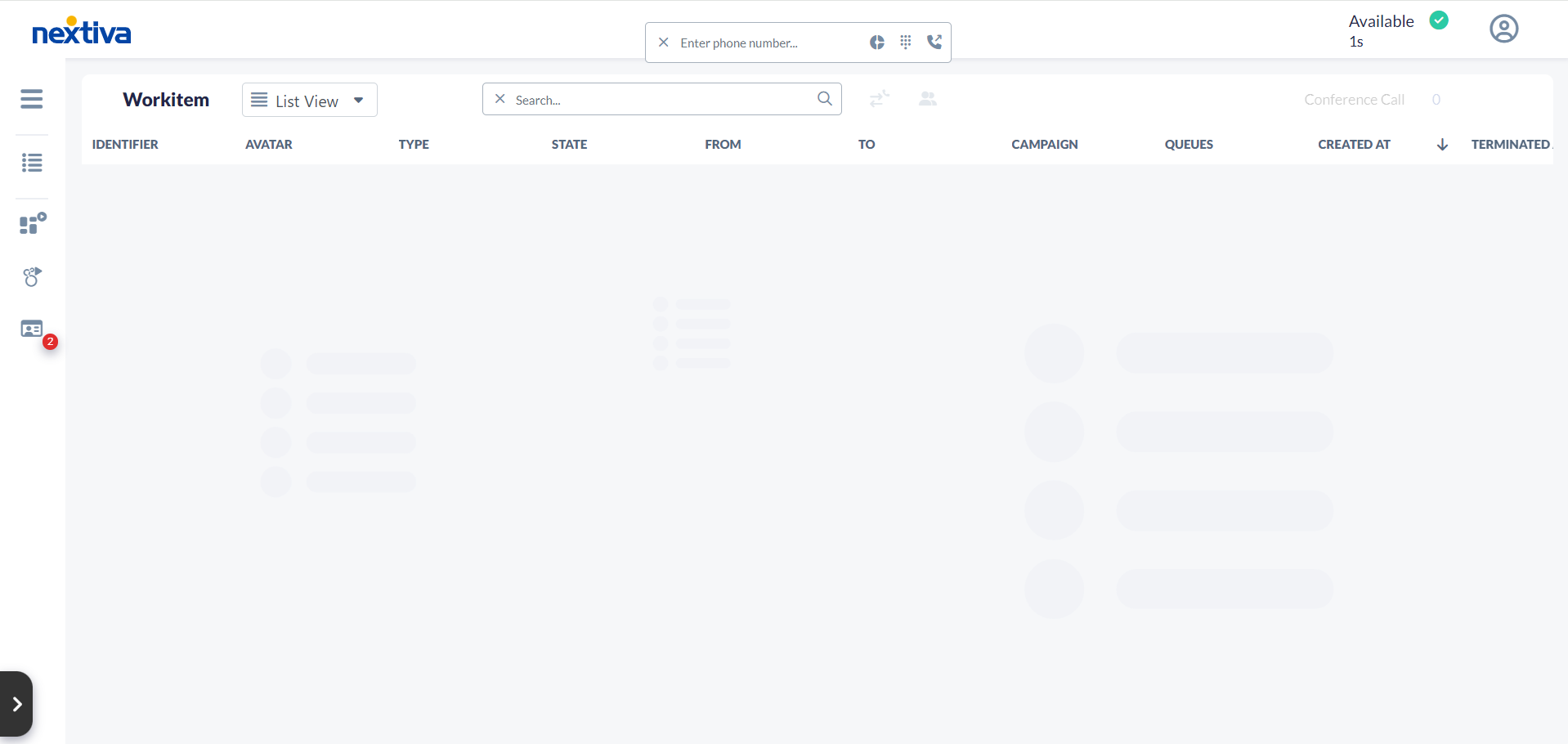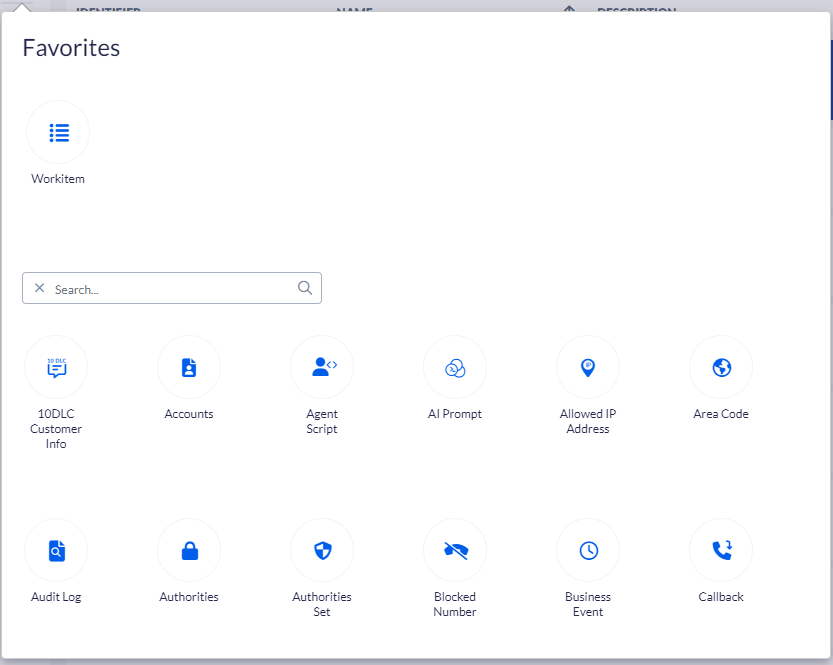The user interface allows various functionalities within the Nextiva system. It consists of a navigation bar on top and a list or detail view on the bottom. You can access different functions depending on whether you are an administrator, agent, supervisor, or any other customized user profile.
The Navigation Bar
The Navigation Bar provides users with various options/functionalities. With the navigation bar, you can manage inbound and outbound workitems on different channels, transfer workitems, and put workitems on hold. You can also change your status within Nextiva Contact Center to accept incoming workitems. The navigation bar is permanent and composed of six distinct areas, giving access to different functionalities based on the profile of the user logged in.
The Navigation Bar consists of:
- The Navigation Menu
- Favorites
- Action
- Control
- Status
- User Menu

The default Navigation Menu consists of the following options/functions:
|
Option |
Functionality |
|
Options |
The first option/function on the left side of the Navigation Bar. When clicked, Options displays the different pages users can see. |
|
Favorites |
The functions that users have configured to be their favorites. These are typically the most used options/functions for users. |
|
Company Directory |
Allows users to communicate with other users, communicate with queues, share files, and create topics with other agents. |
|
Dialpad |
Allows users to make calls. Users can select the dial type and the dial campaign. Users can type the number or use the keyboard. |
|
User Status |
The User Status shows your status within the Nextiva system. This is a user’s availability for incoming workitems. |
|
User Menu |
Allows users shortcuts to send outbound workitems, access user settings, and a link to Knowledge Base articles. |
Favorites

The favorites area is where the user places the most common options/functions they use for easy access. Users can customize the Navigation Bar based on their personal preferences. When an option/ function is added to Favorites, it will be displayed in the Navigation Bar.
Customizing Favorites
To add a component to favorites, search for the Options icon and drag the icon under the Favorites heading.
Action
The action area contains additional functionalities and consists of the dashboards, company directory, and dial pad.
Control
The Control area consists of two buttons that are visible when the phone is off-hook and there is access to the disconnect line and mute action. The disconnect line should not be confused with the hang-up from the workitem. When working off-hook, the line is always connected with the server for fastest connection with the caller since users only must accept the incoming workitem instead of picking the phone.
Status
The status displays a user’s availability to accept incoming workitems through the ACD. Users must be logged in the ACD and have their status set to Available to interact with workitems, unless they are configured to auto-login to the ACD. By clicking on this option, a pop-up will appear allowing the user to select the queues they need to login to, the media they want to receive, and the user status at login. The pop-up will only show the queues and medias the user is allowed to connect to. Once the user is logged in, they can change their status by clicking back on the option. Then a drop-down of different configured statuses will be available. To logout from the ACD, the user must logout from the application using the option in the avatar menu.
User Menu
Refer to the User Status section for more information about the User Menu.
List and Detail View
The bottom portion of the user interface can either be seen in list or detail view.
List View
The list view has a header and data sections. The header gives the ability to search the workitem and/or take actions on the items of the list (add, edit, delete, and duplicate based on user permissions). The user can search keywords and when available, can use the advanced search window and select additional criteria to search on.
The data section is where the results of the search are presented in a grid format that can be filtered and sorted. When selecting workitems in the list by clicking on the row, the possible actions on that item will be available for the user to select them. When the user selects to add or edit an item from the list, the view will switch to the detail view where he will be able to look at the item in greater detail.
Detail View
The detail view is used to adjust the different fields or parameters of a workitem. It is composed of a header, tabs, and data sections. The header section allows the user to go back to the list of records or to act on the current record. The tabs section allows the user to navigate to a specific panel instead of scrolling to it. There is an add button to create new records of an object. When editing an existing record, the changes are saved automatically, while the user is adding a new record, they will need to confirm the creation of the record by saving it with the Save icon.
Wallboard
The Wallboard is accessible if the user is logged in to the ACD. Users can open or close it by clicking on the open/close arrow on the right side of the wallboard section. The Wallboard gives information about the queue the user is logged in to by media type and queue. If an administrator of the system selected the aggregate option, then the Wallboard will show the information for all queues that users belong to.
The Wallboard shows the following statistics:
|
Statistic |
Description |
|
Abandoned |
The amount of workitems that disconnected while still waiting in the queue. |
|
Answered |
The amount of workitems answered in the queue. |
|
AQT (Average Queue Time) |
The average amount of time workitems are waiting in a queue. |
|
In Queue |
The amount of workitems currently waiting in a queue. |
|
MQT (Maximum Queue Time) |
The maximum amount of time workitems are waiting in a queue. |
|
SLA (Service Level Agreement) |
What wait time is acceptable for the queue and how many workitems are abandoned after the acceptable wait time. |
|
Total Transfers |
How many calls have been transferred into the queue. |